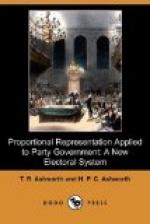The great advantages of this provision are at once apparent. There is no incentive to limit the number of candidates so as to prevent splitting the votes. On the contrary, it is to the interest of each party to get as many strong candidates as possible to stand in its interests. There will be no necessity to ask any candidate to retire for fear of losing a seat to the party. Thus the control of nominations, which leads to the worst abuses of the present system, will be entirely obviated.
Now, suppose that in the instance we have already given each elector is allowed to vote for one candidate only, the total number of votes recorded will be 120,000. Then the unit of representation or number of votes which entitle a party to one senator will be 20,000 votes; each party will be entitled to one senator for every whole unit of representation, and the odd senator will go to the party having the larger remainder. For instance, if the aggregate votes polled by all the Ministerialist candidates be 72,000, and by the Oppositionist candidates 48,000, the Ministerialists, having three units plus 12,000 remainder, are entitled to four senators, and the Opposition, having two units plus 8,000, to two senators.
Similarly, if each elector be allowed to vote for a number of candidates, all these figures will be increased in proportion. For example, if each elector has three votes, the unit of representation would be 60,000 votes. The following general rules may therefore be stated:—
1. The unit of
representation is equal to the total number of valid
votes cast at the election,
divided by the number of seats.
2. Each party is entitled to one seat for every whole unit of representation contained in the aggregate votes polled by all its candidates, and the odd seat goes to the party which has the larger remainder.
The fact that the last seat has to be assigned to the party which has the larger remainder is sometimes advanced as an objection, but it is evidently the fairest possible division that the size of the electorate will permit. Of course, the larger the electorate the more accurately proportioned will be the representation. Hence the representation would be most accurate if the whole assembly were elected in one large electorate. But if, for the sake of convenience, the assembly be elected in a large number of electorates in which the relative proportions of two parties vary the gains which a party makes in some electorates will be balanced by losses in others, so that the final result would be almost as accurate as if the whole country were polled as one electorate. It must be remembered that the result in any electorate cannot be foreseen, and that it is a matter of chance which party gains the advantage. Now, if the limits of variation comprise even a single unit of representation, each party will stand an equal chance of gaining, and therefore




